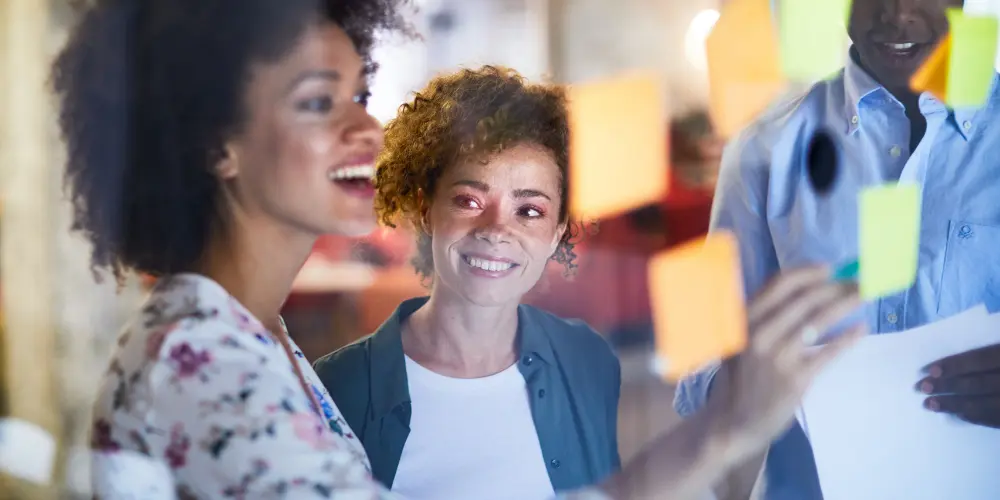
With over 165,000 monthly searches for “passive income,” it’s clear that more people than ever are trying to earn money without trading time for it. But here’s the hard truth: most passive income streams aren’t passive at first. They require upfront effort, experimentation, and smart systems.
Our guide breaks down 30+ battle-tested passive income ideas that actually work, analyzed for startup difficulty, maintenance level, return potential, and scalability. You’ll find real-world tools, Reddit stories, examples from actual creators, and tips to make each stream work for you.
Whether you’re starting from scratch or looking to expand your side income, Deadline Funnel answers the most searched-for questions:
- How can I make a passive income?
- What are the best passive income investment ideas in 2025?
- How to create passive income with no money or experience?
Let’s get into it.
| Idea | Pros | Cons |
| Affiliate marketing | Low cost, scalable, evergreen | SEO competition, requires trust |
| Blogging | Compounds over time, multiple monetization options | Needs SEO strategy and consistency |
| YouTube channel | Multichannel income (ads, affiliates, merch) | Video creation skills & time |
| Selling digital products | High margins, no inventory | Requires audience or marketing |
| Print-on-demand | No inventory, passive sales | Lower margins, saturation risk |
| Online courses | Evergreen, high-ticket | Needs authority or traffic |
| Podcasting | Deep trust, loyal audience | Slow monetization ramp |
| Substack/Email newsletter | Direct reach, sponsor potential | List building takes time |
| REITs | Hands-off real estate | Dividends taxed as income |
| Dividend stocks | Long-term compounding | High upfront investment |
| Stock photography | Ongoing royalties | SEO + saturation |
| Mobile apps | Global reach, recurring revenue | Dev skills or budget needed |
| Automated webinars | Evergreen lead gen + sales | Tech setup required |
| Peer-to-peer lending | Higher ROI than banks | Risk of defaults |
| Buying content sites | Immediate revenue stream | Due diligence needed |
| E-books | Low startup cost, sell forever | Niche audience required |
| Notion/GPT templates | Fast to create, sell on Gumroad | Needs promotion |
| Instagram theme pages | Monetize via shoutouts, links | Growth takes time |
| TikTok automation | Drive affiliate sales, traffic | Unpredictable algo |
| Mobile game apps | Addictive = recurring revenue | Dev time/cost |
| Dropshipping with automation | Low upfront cost | Competitive |
| Niche directories | SEO play, recurring payments | Requires traffic |
| Online marketplaces (NFTs, fonts, 3D assets) | Passive after upload | Niche understanding needed, many scams on the market |
| Subscription communities | Recurring revenue | Community management |
| Investing in creator royalties | Buy fractional rights to songs/videos | New asset class |
| Car rental platforms (Turo) | Asset-backed passive revenue | Maintenance/logistics |
| Domain flipping | Low entry cost, high potential ROI | Research-intensive |
| Vending machines | Physical product automation | Restocking/logistics |
| ATM ownership | Reliable micro-transaction revenue | High capital, security needs |
| Renting storage space | Easy recurring cash flow | Location-dependent |
| Licensing IP | Truly passive once live | Tough entry, legal barriers |
| E-books | Long-term potential, no inventory | Time investment |
Marketing-based passive income ideas
Marketing-based income isn’t passive on day one, but can become your most valuable asset by year two. Marketing-based income strategies use audience building and strategic partnerships with minimal financial investment (usually under $500 to start).
Here’s what the Reddit and Facebook groups won’t tell you: expect to put in 15-20 hours weekly for the first 6 months with exactly $0 in return. But once your systems are dialed in, maintenance drops to 2-5 hours weekly while income continues climbing. Most successful creators break even within 9 months and hit full-time income levels ($4,000+ monthly) between months 18 and 36.
The truth about scaling is that marketing-based income follows a hockey stick pattern: painfully slow growth followed by rapid acceleration once you hit critical mass.

1. Affiliate marketing
Affiliate marketing means recommending products you use and earning a cut when people buy through your link. No inventory, no customer service headaches. Just connect the right products to the right people.
Initial investment: $100-500
- Website or landing pages: $50-150
- Email marketing tool: $20-50/month
- Content creation tools: $0-150
- Tracking software: $0-49/month
Time to first dollar: 3-6 months
Most affiliate marketers see their first commissions within 1-2 months, but reaching consistent income typically takes 3-6 months of content creation and audience building. According to a survey of 2,270 affiliate marketers with different experience levels, the average affiliate marketer earns a bit over $8,000.
Monthly income potential: $500-$15,000+
- Beginning affiliates: $200-1,000/month
- Established affiliates: $1,000-5,000/month
- Top performers: $10,000-40,000+/month
| Pros 🚀 | Cons 🧐 |
| No product creation or inventory management | Requires audience building or paid traffic |
| Commission rates from 5% (Amazon) to 50%+ (digital products) | Income fluctuates with seasonal trends and promotions |
| Minimal customer service responsibilities | Commission structure changes can impact earnings overnight |
| Can be integrated into existing content platforms | Needs regular content creation and link updating |
✅ Reality check: Pat Flynn openly shares his affiliate marketing journey through reports on Smart Passive Income. His first three months generated less than $200 in total.
The breakthrough came in month 7, when he created detailed comparison content between two hosting providers rather than generic reviews.
His affiliate revenue now exceeds $100,000 monthly, but it took over a year of consistent content creation before it reached $10,000 monthly.
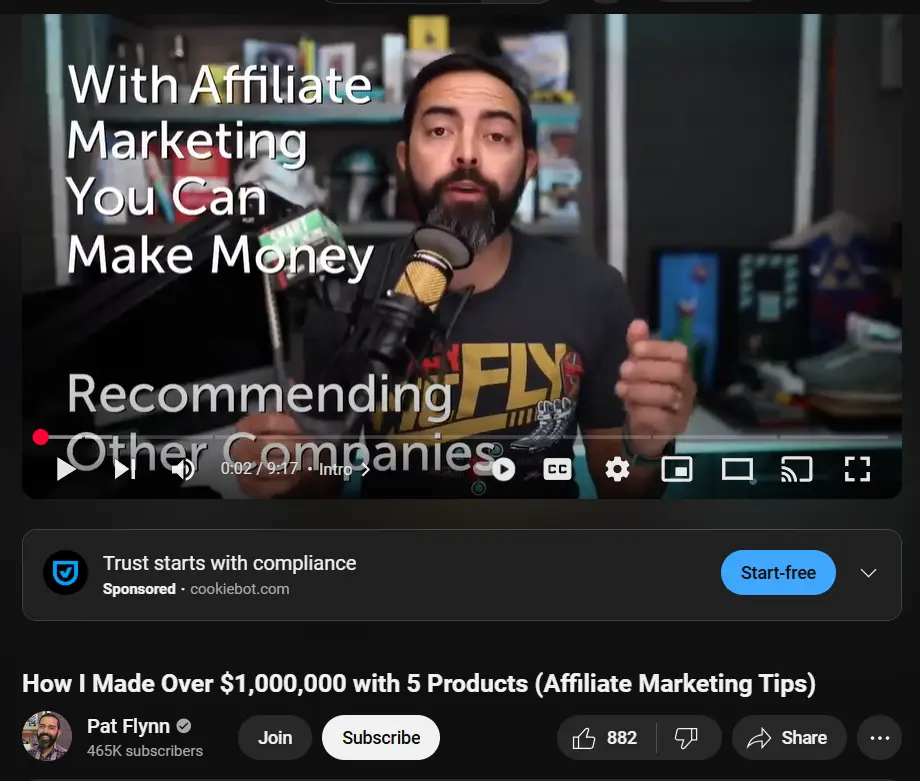
Source: Youtube.com
The main difference is that he only promotes products he personally uses and creates detailed resource pages – something that has a big value when it comes to affiliate marketing transparency.
Action step: If you want to get started with affiliate marketing, select 3-5 products you genuinely use and create comprehensive resource centers for each (comparison charts, tutorials, FAQs, case studies).
2. Blogging
Blogging transforms your knowledge into a digital asset that generates income through multiple revenue streams, including display advertising, affiliate marketing (mentioned above), and product sales.
Initial investment: $200-500
- Domain name: $10-15/year
- Web hosting: $5-25/month
- Premium WordPress theme: $50-100 (one-time)
- Basic SEO tools: $0-100/month
Time to first dollar: 6-12 months
The typical blog takes 6-8 months to begin generating even minimal traffic due to Google’s “sandbox” period for new sites. According to income reports from 100+ bloggers, most didn’t see meaningful revenue ($500+/month) until around the 12-month mark with consistent content creation.
Monthly income potential: $500-$20,000+
- New blogs (1-2 years): $500-2,000/month
- Established blogs (2-4 years): $2,000-8,000/month
- Authority blogs (4+ years): $8,000-20,000+/month
| Pros 🚀 | Cons 🧐 |
| Multiple monetization options (ads, affiliates, products, sponsorships) | Requires 30-50 quality articles before generating meaningful traffic |
| Content remains valuable for years (some posts generate traffic for 5+ years) | Google algorithm updates can slash traffic by 30-50% overnight |
| Minimal technical skills required to start | Extremely competitive in popular niches like personal finance, travel, and health |
| Can be built around topics you genuinely enjoy | Results typically take 12+ months, even with consistent effort |
✅Reality check: Take a look at Adam Enfroy’s blog journey from $0 to $350,000+ monthly in under three years. What most aspiring bloggers miss: he published 80+ articles in his first year while working full-time and focused heavily on link building. His first 6 months generated modest income despite publishing 2-3 articles weekly. The hockey-stick growth didn’t begin until month 10, when his content started ranking for competitive keywords.
Action step: If you want to turn your blog into a passive income machine, instead of tackling ultra-competitive head terms, use tools like Ahrefs, Mangools or Search Atlas for keyword research. Find “low competition, high value” keywords with KD (Keyword Difficulty) scores under 20 but with commercial intent.
3. YouTube channel
YouTube channels convert your knowledge, personality, and video creation skills into passive income streams through advertising, sponsorships, affiliate marketing, and product sales.
Initial investment: $500-2,000
- Camera (entry-level): $400-800
- Microphone: $70-200
- Basic lighting: $50-150
- Video editing software: $0-300/year
- Thumbnails and graphics: $0-50/month
Time to first dollar: 3-6 months
YouTube’s Partner Program requires 1,000 subscribers and 4,000 watch hours before monetization.
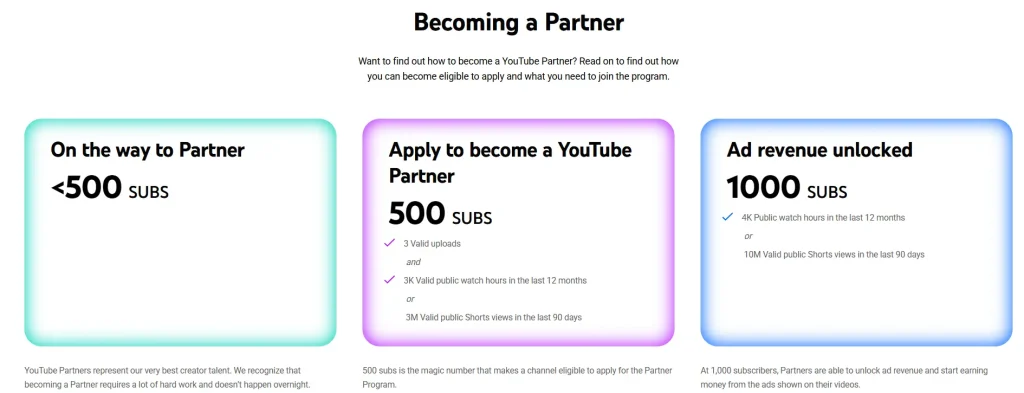
Source: YouTube.com
The average creator reaches these thresholds in 4-6 months with consistent weekly uploads, although niches like tutorials and product reviews can monetize faster through affiliate links before ad eligibility.
Monthly income potential: $500-$20,000+
- New channels (under 10K subscribers): $100-1,000/month
- Growing channels (10K-100K subscribers): $1,000-5,000/month
- Large channels (100K+ subscribers): $5,000-20,000+/month
| Pros 🚀 | Cons 🧐 |
| Multiple revenue streams (ads, affiliates, sponsorships, products) | Higher production requirements than text-based content |
| Long-term content value (videos can generate views for years) | Requires comfort on camera or strong editing skills |
| Built-in discovery algorithm and audience | Algorithm changes can significantly impact views and revenue |
| Can build a personal brand while generating income | More time-intensive than other passive options (8-20 hours weekly) |
✅Reality check: For example, Graham Stephan, a real estate agent turned YouTuber, experienced modest initial growth. His first 20 videos averaged fewer than 1,000 views each. But by consistently producing content, he eventually grew his channel to over 5 million subscribers and now earns approximately $37,800 per month from YouTube ad revenue.
Today, his older videos on evergreen topics like credit cards and investing fundamentals continue generating thousands of dollars monthly without additional work.
Action step: Start with “comparison” videos in your niche (Product A vs. Product B, Method X vs. Method Y) instead of broad topics.
4. Selling digital products
Digital products transform your knowledge and creativity into downloadable assets that sell automatically with near-zero ongoing costs, offering the highest profit margins of any passive income stream.
Initial investment: $100-1,000
- Website or storefront: $0-500
- Payment processing: $0 upfront (2.9-5% per transaction)
- Design software/tools: $0-50/month
- Marketing tools: $50-200/month
Time to first dollar: 1-3 months
Unlike content platforms that require audience building before monetization, digital products can generate sales immediately with the right positioning and marketing. Creators typically make their first sales within 30-60 days of product launch if they build an effective sales funnel.
Monthly income potential: $300-$10,000+
- New creators: $300-1,000/month
- Established creators: $1,000-5,000/month
- Top performers: $5,000-10,000+/month
| Pros 🚀 | Cons 🧐 |
| Incredible profit margins (90-95% after payment processing) | Equipment and editing learning curve |
| Unlimited sales potential without additional work | Consistent publishing schedule essential for growth |
| No inventory, shipping, or physical production | Most shows need 5,000+ downloads per episode for premium sponsors |
| Can be created with minimal technical knowledge | Production takes 4-5 hours per published hour of content |
✅Reality check: Justin Jackson from TransistorFM shares his journey building digital products. His initial eBook generated modest revenue despite his established audience. However, his third product, “Marketing for Developers,” achieved significant success by addressing a specific pain point. This targeted approach led to substantial earnings, with Podia reports indicating over $100,000 in income from the website.
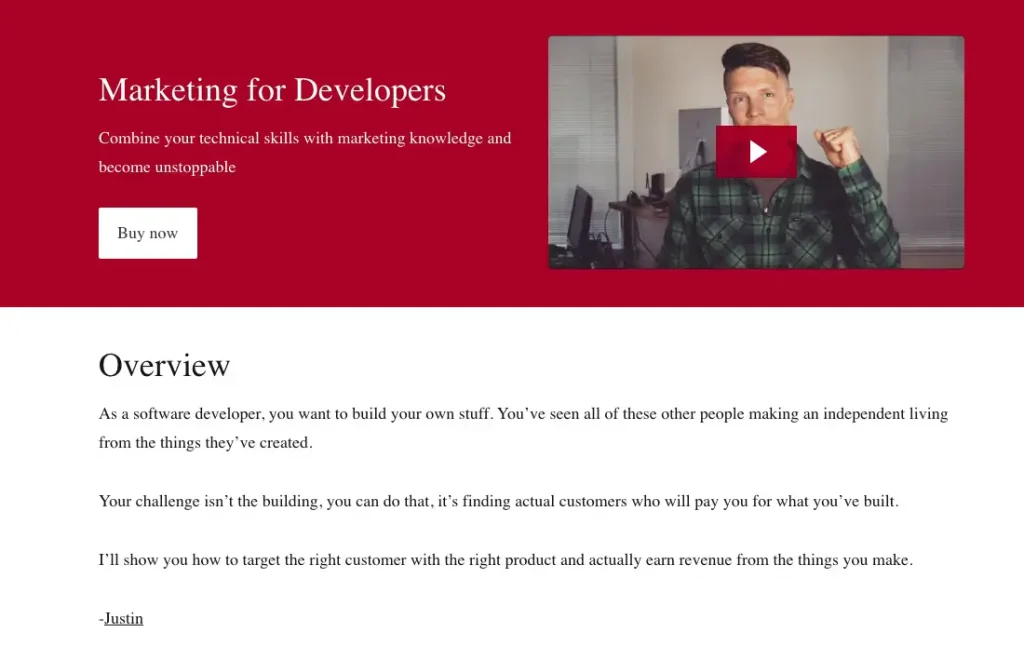
Source: podia.com
Justin’s example underscores the importance of focusing on a well-defined niche and offering tailored solutions to accomplish success in digital product ventures.
Action step: Before creating your product, validate demand by pre-selling to a small audience or creating a “minimum viable version” at a 50% discount.
4. Print-on-demand
Print-on-demand transforms your designs into physical products without inventory, upfront production costs, or fulfillment headaches by using platforms that print and ship only after customers order.
Initial investment: $0-500
- Design software: $0-50/month (or free alternatives)
- Mockup tools: $0-20/month
- Print-on-demand platform: $0 upfront
- Marketing: $50-200 for initial promotion
Time to first dollar: 1-3 months
Print-on-demand platforms like Printful, Printify, or Merch by Amazon can generate sales within days of uploading designs, though building consistent income typically takes 2-3 months of design uploads and marketing efforts.
Monthly income potential: $ 200-$ 5,000+
- Casual designers: $200-500/month
- Dedicated creators: $500-2,000/month
- Top performers: $2,000-5,000+/month
| Pros 🚀 | Cons 🧐 |
| Zero inventory risk or upfront production costs | Lower profit margins (15-30%) than pure digital products |
| No fulfillment, shipping, or customer service headaches | Platform dependence and competition |
| Multiple product types from a single design | Requires a volume of designs for meaningful income |
| Can be started with minimal design skills using templates | Seasonal fluctuations in some niches |
✅Reality check: Taylor Posada, a 28-year-old entrepreneur from Baltimore, scaled her second print-on-demand Etsy shop to $48,000 in profits within four months.
Initially, she sold low-ticket items like tote bags and apparel for events. Recognizing the potential in higher-priced products, she transitioned to selling custom event signs. Through careful market research, Etsy ads, and an analytical approach to product listings, Taylor achieved remarkable success.
In November 2024 alone, she made over $29,000 in profit.
Action step: Instead of chasing trends, use tools like Merch Informer or Etsy search volume data to identify “evergreen niches” with consistent demand year-round.
5. Online courses
Online courses package your expertise into a premium digital product that sells for higher prices than e-books or templates while solving specific problems for your audience.
Initial investment: $200-2,000
- Course platform: $30-200/month
- Video recording equipment: $100-1,000
- Screen recording software: $0-200
- Course materials design: $0-500
Time to first dollar: 1-3 months
Course creation typically takes 1-2 months for a comprehensive product, with sales beginning immediately after launch through direct marketing.
Most successful courses start generating revenue within 30 days of completion with proper audience building and effective online teaching methods.
Monthly income potential: $500-$20,000+
- New course creators: $500-2,000/month
- Established creators: $2,000-8,000/month
- Top performers: $8,000-20,000+/month
| Pros 🚀 | Cons 🧐 |
| High price points ($100-2,000) compared to other digital products | Significant time investment (40-100+ hours) for quality creation |
| Exceptional profit margins (70-90% after platform fees) | Requires existing audience or marketing budget for successful launch |
| Leverages the expertise you already possess | Platform fees eat into profits (Teachable charges 5% + $1 per transaction) |
| Scalable to unlimited students without additional work | Market expectations for production quality increasing yearly |
✅Reality check: Graham Cochrane, founder of The Recording Revolution, has built a successful online business generating over $1.2 million annually while working 5 hours a week, primarily through online courses. His courses, such as Mixing University and Total Home Recording, are priced between $147 and $297.
His first course, focusing on the Pro Tools software, was developed in response to audience demand for in-depth tutorials beyond the constraints of YouTube’s video length limits at the time. This initial product laid the foundation for his future offerings. It took him $500 to start a multimillion-dollar business.
Action step: Before building your full course, create and sell a $27-47 “pilot workshop” addressing one specific problem and make sure you find the right platform for your online course.
6. Podcasting
Podcasting creates an intimate connection with your audience through audio content that can be monetized through sponsorships, affiliate marketing, and product sales.
Initial investment: $300-1,000
- Microphone and audio interface: $150-500
- Podcast hosting: $15-30/month
- Audio editing software: $0-200
- Cover art and branding: $0-200
Time to first dollar: 3-6+ months
Most podcasts require 10-20 episodes and consistent growth before attracting sponsors or generating meaningful affiliate revenue. According to Hello Audio, it takes the average monetized podcast 6-18 months to begin generating revenue.
Monthly income potential: $300-$10,000+
- New podcasts (under 1,000 downloads/episode): $100-500/month
- Growing podcasts (1,000-10,000 downloads/episode): $500-3,000/month
- Popular podcasts (10,000+ downloads/episode): $3,000-10,000+/month
| Pros 🚀 | Cons 🧐 |
| Lower competition than blogs or YouTube (only 2 million active podcasts vs. 600M+ blogs) | Equipment and editing learning curve |
| Higher engagement and conversion rates than most content platforms | Consistent publishing schedule essential for growth |
| Multiple monetization methods (sponsors, affiliates, products) | Most shows need 5,000+ downloads per episode for premium sponsors |
| Can repurpose content across multiple platforms | Production takes 4-5 hours per published hour of content |
✅Reality check: John Lee Dumas of Entrepreneurs on Fire publishes his income reports openly, showing his journey from $0 to $200K+ monthly. For instance, in July 2024, the podcast reported a gross income of $170,866.
During the initial phase of his podcast, specifically the first nine months, the show generated no revenue. The tipping point came at 18 months when consistent daily episodes and strategic guest selection created enough momentum to attract major sponsors paying $15K+ monthly.
Dumas has mentioned that he now dedicates one day per week to batch-record interviews, letting his team handle production and other aspects of the business.
Action step: Instead of launching a standalone podcast, partner with 2-3 established creators in your niche to create a roundtable show, instantly leveraging their existing audiences.
7. Substack/email newsletter
Email newsletters convert your expertise into subscription revenue, affiliate income, and product sales through direct audience relationships not subject to platform algorithms.
Initial investment: $50-300
- Substack or alternative platform: $0 upfront (10% of subscription revenue)
- Basic design and branding: $0-200
- Initial promotion: $50-100
Time to first dollar: 3-6 months
Free newsletters can monetize through affiliate marketing within 1-2 months, while paid subscription models typically require 3-6 months of consistent publishing to build enough trust for conversions. Newsletters reaching 1,000 subscribers typically begin monetizing successfully.
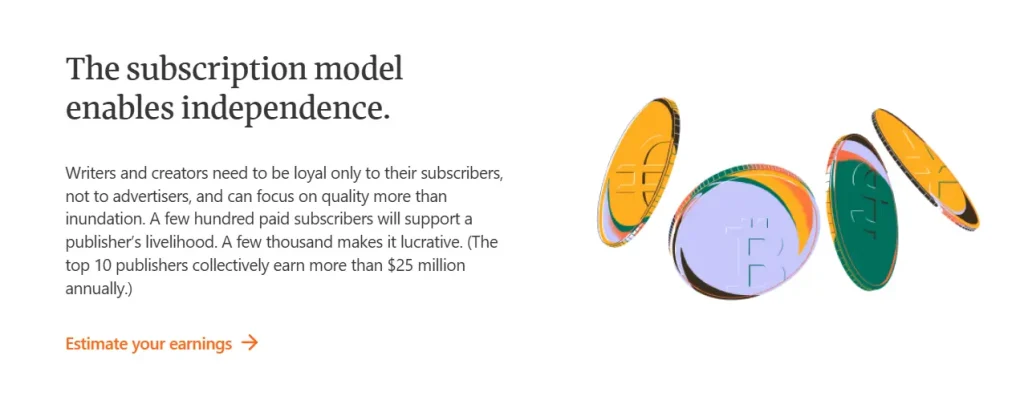
Source: substack.com/about
Monthly income potential: $200-$10,000+
- New newsletters (under 1,000 subscribers): $100-500/month
- Growing newsletters (1,000-5,000 subscribers): $500-3,000/month
- Popular newsletters (5,000+ subscribers): $3,000-10,000+/month
| Pros 🚀 | Cons 🧐 |
| Direct relationship with audience not subject to algorithm changes | Challenging to grow subscriber base without existing platform |
| Multiple revenue streams (subscriptions, affiliates, sponsorships) | Consistent publishing schedule required (weekly minimum) |
| Lower content production requirements than video or podcasting | Subscription fatigue making conversion more difficult |
| High engagement rates (40-60% open rates for targeted newsletters) | Platform fees on paid newsletters (10% on Substack) |
✅Reality check: Packy McCormick’s journey with his newsletter, Not Boring, exemplifies the challenges and rewards of building a successful digital publication. After nearly a year of writing, his subscriber count was still under 1,000.
By consistently producing high-quality content and engaging with his audience, within the next year, his subscriber base expanded to 50,000, and eight months later, it surpassed 100,000. As of late 2024, Not Boring has over 183,000 subscribers and generates more than $3 million annually.
Action step: First, build an audience with a free newsletter focused on a specific professional niche, then introduce a premium tier once you reach 1,000+ subscribers. Automate your email marketing sequence to relieve manual efforts and make this income stream as passive as possible.
Investment-based passive income ideas
Investment-based income requires capital upfront but minimal ongoing effort. Most successful investors diversify across multiple assets – they are not betting everything on one option.
The reality of investing: expect 1-3 years of education before making significant investments. The highest-performing portfolios typically combine 3-5 different asset classes instead of chasing single-category returns.
8. REITs (Real Estate Investment Trusts)
REITs let you invest in real estate portfolios without directly owning properties. They’re legally required to distribute 90% of taxable income to shareholders.
Initial investment: $100-1,000+
- Publicly-traded REIT shares: $10-100+ per share
- REIT ETFs: $50-200 per share
Time to first dollar: Immediate to 90 days
Most REITs pay quarterly dividends.
Monthly income potential: $8-$83 per $1,000 invested
- Conservative REITs: 3-5% annual yield
- Mid-range REITs: 5-8% annual yield
- High-yield REITs: 8-10%+ annual yield
| Pros 🚀 | Cons 🧐 |
| No property management headaches | Dividends taxed as ordinary income |
| Higher yields than most stocks (4-8%) | More volatile during market downturns |
| Liquidity for publicly traded REITs | Sensitive to interest rate changes |
| Lower minimum investment than direct real estate | Management fees reduce returns |
✅ Reality check: Different REIT sectors face specific challenges. Retail REITs battle e-commerce disruption, office REITs struggle with work-from-home trends, and all REITs rely heavily on debt financing that creates risk during economic downturns.
Investors have no control over property decisions, and management quality really varies. During market stress, REITs can experience dramatic price volatility. For example, during the 2020 pandemic, many slashed or suspended their supposedly reliable dividends.
Action step: Focus on REITs with conservative payout ratios (below 80% of FFO, ie. funds from operations) and consistent dividend growth over 5+ years.
9. Dividend stocks
Dividend stocks represent ownership in companies that distribute profits to shareholders, typically quarterly.
Initial investment: $100-1,000+
- Individual dividend stocks: $20-500+ per share
- Dividend ETFs: $50-200 per share
Time to first dollar: 1-90 days
Companies typically pay dividends quarterly.
Monthly income potential: $1.67-$50 per $10,000 invested
- Low-yield dividends: 1-2% annual yield
- Medium-yield dividends: 2-4% annual yield
- High-yield dividends: 4-6%+ annual yield
| Pros 🚀 | Cons 🧐 |
| Built-in inflation protection through company growth | Requires larger capital for meaningful income |
| Lower tax rates on qualified dividends | Company-specific risks affect dividends and share price |
| Potential capital appreciation alongside income | Dividend cuts possible during economic downturns |
| Research required to avoid dividend traps |
✅ Reality check: According to a Hartford Funds white paper, since 1960, approximately 82% of the S&P 500’s total return can be attributed to reinvested dividends and the power of compounding.
In 2010, P&G’s stock traded around $60 per share. By 2014, the company offered a dividend yield of approximately 3.2%, with an annual dividend payout of $2.57 per share. Fast forward to April 2025, P&G’s annual dividend payout has increased to $4.03 per share, resulting in an effective yield of about 6.7% on the original 2010 investment.
Action step: Build a portfolio of 10-15 “Dividend Aristocrats” (companies with 25+ years of consecutive dividend increases) or start with dividend growth ETFs like SCHD or VIG.
10. Peer-to-peer (P2P) lending
Peer-to-peer (P2P) lending connects individual lenders with borrowers through online platforms, allowing you to earn interest by funding loans.
Initial investment: $500-2,500
- Minimum per loan: $25-50
- Recommended starter: $500 (diversified across 20+ loans)
Time to first dollar: 30-60 days
Borrowers typically make monthly payments.
Monthly income potential: $25-$92 per $10,000 invested
- Conservative portfolios: 3-5% annual returns
- Balanced portfolios: 5-8% annual returns
- Aggressive portfolios: 8-11%+ annual returns
| Pros 🚀 | Cons 🧐 |
| Higher returns than savings accounts or CDs | Default risk increases during economic downturns |
| Monthly income stream | Limited liquidity |
| Access to an asset class traditionally limited to banks | Interest taxed as ordinary income |
| Automated investing options | Some platforms require an accredited investor status |
✅ Reality check: P2P lending platforms like Prosper and LendingClub connect individual investors with borrowers, offering an alternative investment opportunity.
As of September 30th, 2024, Prosper reported a weighted average historical return of 5.3% for loans originated since July 1, 2009. This figure accounts for actual payments received by investors, net of fees and losses.

Source: prosper.com
Action step: Start with no more than 5% of your investment portfolio across at least 100 different loans using conservative automated strategies focused on A and B-grade borrowers.
11. Buying established content sites
Purchasing existing blogs or e-commerce stores that already generate traffic and revenue skips the 1-2 year growth phase.
Initial investment: $5,000-100,000+
- Small niche sites: $5,000-15,000
- Medium authority sites: $15,000-50,000
- Large authority sites: $50,000-100,000+
Time to first dollar: Immediate
Established sites generate revenue immediately after purchase.
Monthly income potential: $100-$3,333+ per $10,000 invested
- Content sites: 12-24% annual ROI
- Affiliate sites: 20-36% annual ROI
- E-commerce stores: 24-40%+ annual ROI
| Pros 🚀 | Cons 🧐 |
| Immediate traffic and revenue | Significant due diligence required |
| Verified earnings history | Traffic and income can drop if mismanaged |
| Existing content, backlinks, and authority | Higher upfront investment than building from scratch |
| Historical data for growth analysis | Algorithm updates can impact established sites |
✅ Reality check: An individual purchased an Amazon Associates business for $157,000 in February 2019. At the time of acquisition, the site was generating an average net profit of $4,200 per month. The new owner was able to increase the monthly net income to over $12,000 within less than a year.
Action step: Run a full technical audit before purchasing and verify income through at least 6 months of payment screenshots or account access.
Creative passive income ideas
Creative passive income ideas leverage your skills and intellectual property to generate ongoing revenue from work created once.
The key insight: focus on fewer, higher-quality assets preferably than constantly producing new material. Top performers typically generate 80% of their income from just 20% of their creative output.
12. Stock photography
Stock photography involves creating and licensing visual content for others to use in their projects, generating royalties each time someone downloads your work.
Initial investment: $500-3,000
- Professional camera: $500-1,500
- Editing software: $10-50/month
Time to first dollar: 30-90 days
Most stock platforms pay monthly, with a minimum threshold before issuing payments.
Monthly income potential: $50-$1,000+
- Hobbyist photographers (100-500 images): $50-200/month
- Part-time contributors (500-2,000 images): $200-500/month
- Full portfolio (2,000-5,000+ images): $500-1,000+/month
| Pros 🚀 | Cons 🧐 |
| Images can generate income for 5-10+ years | Declining per-image revenue over the past decade |
| Extremely scalable with a growing portfolio | Extremely competitive market |
| Multiple platforms can license the same content | Requires regular uploads to maintain visibility |
| Technical skills more important than artistic brilliance | Income increases slowly over years |
✅ Reality check: According to Photutorial, photographers typically earn between $0.02 and $0.25 per stock photo per month, depending on factors like image quality, subject matter, and licensing agreements. With a portfolio of 3,000 images, annual earnings of around $24,000 are plausible.
It’s also common for earnings to grow over time as images accumulate downloads. For instance, Diana Mironenko, a successful stock photographer, reports earning between $20 and $700 per photo, with her most popular images earning significantly more.
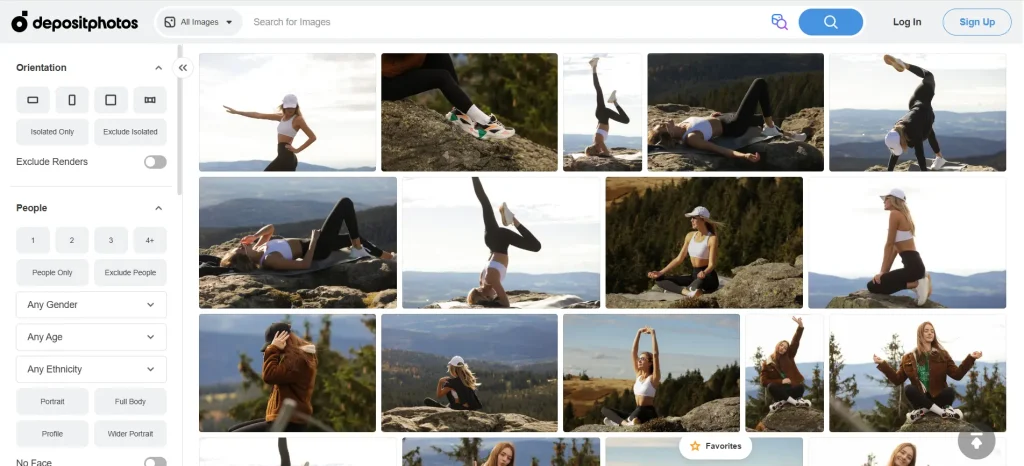
Stock photos by Diana Mironenko. Source: depositphotos.com
Similarly, Jade, another stock photographer, earns over $20,000 monthly from her iPhone photos.
Action step: Analyze the top-selling images in 2-3 specific categories and create 50-100 images addressing similar commercial needs with your unique style.
13. Mobile apps
Mobile apps generate passive income through paid downloads, in-app purchases, subscriptions, and advertising revenue.
Initial investment: $1,000-10,000+
- DIY development: $500-1,000
- Hiring developers: $3,000-10,000+ per app
Time to first dollar: 60-120 days
App stores typically pay on a 30-60 day delay after the month in which revenue was earned.
Monthly income potential: $100-$10,000+
- Simple utility apps: $100-500/month
- Mid-complexity apps or tools: $500-2,000/month
- High-retention subscription apps: $2,000-10,000+/month
| Pros 🚀 | Cons 🧐 |
| Global market access through app stores | Significant technical skills required |
| Multiple monetization methods | Highly competitive marketplace |
| Potential for viral growth | Ongoing maintenance for OS updates |
| Can be updated and improved over time | App store commission fees (15-30%) |
✅ Reality check: “Calm”, a meditation app, is a great example of passive income through a mobile app. Once the app was developed and launched in 2011, it began generating revenue mainly through subscriptions.
While there was significant initial effort to create and launch the app, the income from “Calm” became increasingly passive over time due to its subscription model.
Action step: Create a simple landing page with screenshots of your proposed app and run small-scale ads ($200) to measure click-through and sign-up rates before going in on development.
14. Automated webinars
Automated webinars allow you to record a presentation once and run it on a schedule, creating the experience of a live event while generating leads and sales 24/7.
Initial investment: $500-2,000
- Webinar platform: $50-200/month
- Video recording equipment: $200-1,000
Time to first dollar: 30-60 days
Most automated webinar systems begin generating leads immediately, especially if you follow evergreen webinar conversion strategies. Sales conversion typically starts within 1-2 months.
Monthly income potential: $500-$20,000+
- Entry-level implementation: $500-2,000/month
- Optimized mid-tier systems: $2,000-10,000/month
- High-ticket funnels: $10,000-20,000+/month
| Pros 🚀 | Cons 🧐 |
| Present once, earn repeatedly | Requires strong presentation and sales skills |
| Scales without additional time investment | Technical setup more complex |
| Higher conversion rates than text or static video | Advertising costs to drive registrations |
| Can sell high-ticket items ($500-5,000+) | Regular updates needed to maintain relevance |
✅ Reality check: Amy Porterfield’s course “Digital Course Academy” generates over $4 million annually, primarily through automated webinars. Before achieving this success, she recorded and scrapped seven different webinar versions over 14 months. Her breakthrough came when she shifted from teaching comprehensive strategies to solving a specific pain point.
Action step: Focus on solving one specific problem your audience faces in a 45-60 minute presentation with a clear transformation promise.
15. Notion/GPT templates
Notion templates and AI prompts transform your knowledge of digital tools into passive income by creating reusable workflows and systems.
Initial investment: $50-500
- Notion Pro account: $8/month
- Landing page: $0-20/month
Time to first dollar: 7-30 days
Templates can be created and listed for sale within days.
Monthly income potential: $100-$5,000+
- Beginners (1-3 templates): $100-500/month
- Established creators (5-10 templates): $500-2,000/month
- Top performers (10+ templates): $2,000-5,000+/month
| Pros 🚀 | Cons 🧐 |
| Low development cost | Price sensitivity (most templates sell for $10-50) |
| Extremely fast to create | Market saturation in popular categories |
| Minimal technical skills required | Requires visual design skills |
| High profit margins (90%+) | Updates needed as platforms evolve |
✅ Reality check: Thomas Frank, a productivity YouTuber and Notion expert, has achieved significant success with his Notion templates. In 2021, he earned approximately $15,000 per month from his “Creator’s Companion” template, with prices ranging from $49 to $179. By 2022, his revenue from Notion templates reached $1 million.
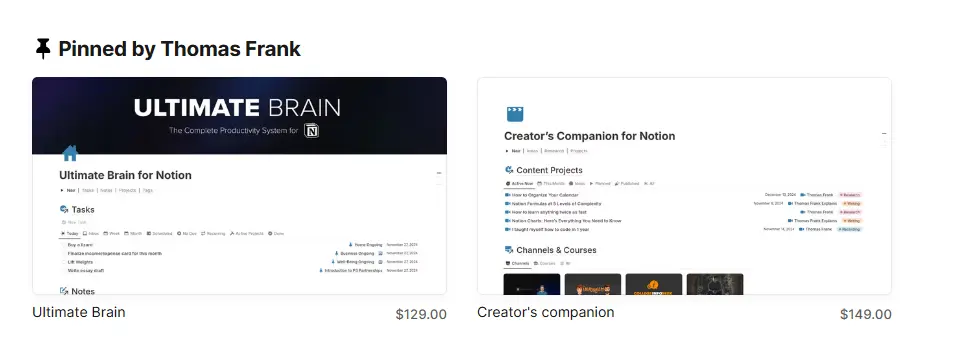
Source: notion.com/@thomas
Action step: Identify a specific workflow challenge in your professional niche, then design a template that solves that exact problem with clear documentation and tutorials.
16. Instagram theme pages
Instagram theme pages curate content around specific niches, monetizing through sponsored posts, affiliate marketing, and product promotions.
Initial investment: $0-500
- Content curation tools: $0-30/month
- Scheduling software: $0-25/month
Time to first dollar: 90-180 days
Most theme pages require at least 10,000 followers before monetization.
Monthly income potential: $200-$10,000+
- Small pages (10K-50K followers): $200-1,000/month
- Medium pages (50K-250K followers): $1,000-3,000/month
- Large pages (250K+ followers): $3,000-10,000+/month
| Pros 🚀 | Cons 🧐 |
| Zero content creation required (curation only) | Requires 3-5 posts daily for optimal growth |
| The algorithm favors consistent, niche-focused posting | Platform policy changes affect reach |
| Multiple monetization methods | Account suspension risks from copyright issues |
| Can be managed in 30-60 minutes daily | Declining organic reach compared to previous years |
✅ Reality check: A user on r/InstagramMarketing reported that their spirituality-themed page reached 19.7K followers with an engagement rate of 9.4% and a 30-day reach of 1 million. Another user attests to growing from 5K to 750K followers in 3 years and making up to $120K/year.

Source: https://www.reddit.com/r/InstagramMarketing/
Action step: Analyze 50+ existing pages in your niche for their most engaging content types and create a consistent posting schedule of at least 3 daily posts.
17. TikTok automation
TikTok automation involves creating, scheduling, and monetizing content consistently without daily hands-on management.
Initial investment: $200-1,000
- Content creation tools: $0-50/month
- Content researcher/creator: $100-500/month
Time to first dollar: 30-90 days
TikTok accounts can reach monetization thresholds faster than other platforms.
Monthly income potential: $300-$15,000+
- New accounts (under 10K followers): $300-1,000/month
- Growing accounts (10K-100K followers): $1,000-5,000/month
- Viral accounts (100K+ followers): $5,000-15,000+/month
| Pros 🚀 | Cons 🧐 |
| Faster organic growth than most platforms | Algorithm changes frequently |
| Higher engagement rates | Requires fresh content ideas consistently |
| Content can go viral regardless of follower count | True automation requires hiring content creators |
| Less saturation in many niches compared to YouTube | Account/platform stability concerns |
✅ Reality check: Candice Bannister transformed her home-based cupcake business into a thriving enterprise, generating £6,000 weekly through TikTok alone by showcasing cake decorations in live sessions. Starting with a £300 investment, her engaging content led to an amazing £167,000 in revenue within a year.
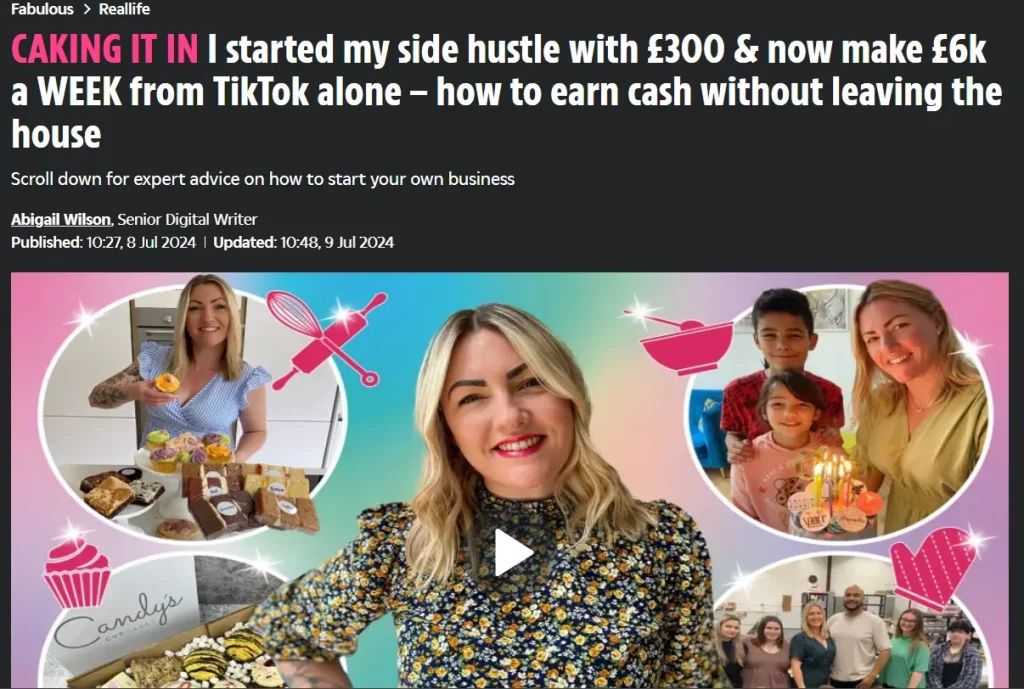
Source: thescottishsun.co.uk
Action step: Create a content batch-production system where you film 15-20 videos in a single day, then schedule them across 2-3 weeks.
18. Mobile game apps
Mobile game apps generate passive income through in-app purchases, advertising, and subscription models.
Initial investment: $2,000-20,000+
- Game development: $1,000-15,000
- Art and sound assets: $500-3,000
Time to first dollar: 90-180 days
Game apps typically begin generating revenue immediately after launch, but payment delays mean first payouts arrive 2-6 months after release.
Monthly income potential: $300-$50,000+
- Casual games, low downloads: $300-1,000/month
- Mid-tier games, moderate success: $1,000-10,000/month
- Hit games, high engagement: $10,000-50,000+/month
| Pros 🚀 | Cons 🧐 |
| Higher user retention than utility apps | Higher development costs than standard apps |
| Multiple monetization strategies | Extremely competitive market |
| Potential for viral growth | User acquisition costs increasing yearly |
| Evergreen content that can generate income for years | Requires ongoing updates |
✅ Reality check: “2048”, a simple puzzle game, was created by Gabriele Cirulli in 2014. It was developed as a hobby with no upfront investment. It quickly went viral due to its addictive gameplay and minimalist design.
While Cirulli offered the game for free, the monetization came from ads integrated into the game. Over time, the game continued to generate consistent income through these ads, even as its updates slowed down.
Action Step: Focus on underserved game niches with passionate audiences but less competition and test your core gameplay loop with simple prototypes. Ensure your app meets market demands before investing in full development.
19. Dropshipping with automation
Dropshipping with automation creates passive e-commerce income by taking advantage of software to handle inventory management, order processing, and customer service.
The store owner lists products from a third-party supplier, and when a customer places an order, the software automatically forwards the order to the supplier, who ships it directly to the customer, eliminating the need to hold stock or manually fulfill orders.
Initial investment: $1,000-5,000
- E-commerce platform: $30-300/month
- Automation tools: $50-200/month
- Product testing: $300-1,000
Time to first dollar: 15-60 days
Well-targeted dropshipping stores typically generate first sales within 2-8 weeks of launch.
Monthly income potential: $500-$15,000+
- Beginning stores: $500-2,000/month profit
- Established stores: $2,000-5,000/month profit
- Scaled operations: $5,000-15,000+/month profit
| Pros 🚀 | Cons 🧐 |
| No inventory risk | Lower profit margins than private-label products |
| Location independence | Customer service challenges |
| Highly automatable with the right tools | Increasing advertising costs |
| Scalable across multiple stores | Higher competition in popular niches |
✅ Reality check: Maddy Glynn, an entrepreneur in her 20s, transformed her life through dropshipping leggings as her ‘lazy girl side hustle’. Starting with less than £800, she has reported earning over £78,000 monthly in 2024, working just two hours daily.
Action step: Set up automated cart abandonment emails that run in the background and begin recovering sales immediately without additional effort from you.
20. Niche directories
Niche directories create passive income by collecting and organizing specialized information that’s valuable to specific audiences.
Initial investment: $500-3,000
- Website development: $300-2,000
- Directory software: $50-300
Time to first dollar: 60-120 days
Most directories require at least 100-200 quality listings before monetization.
Monthly income potential: $300-$10,000+
- New directories: $300-1,000/month
- Established directories: $1,000-5,000/month
- Authority directories: $5,000-10,000+/month
| Pros 🚀 | Cons 🧐 |
| Recurring revenue through subscriptions or listings | Significant upfront work collecting initial listings |
| Value increases with directory size and age | “Chicken and egg” problem attracting first paying listings |
| Low ongoing content creation requirements | Value proposition must be clear to justify fees |
| SEO advantages in specialized niches | Competition from free resources |
✅ Reality check: A verified example of a successful niche directory is The Knot, an online platform that connects engaged couples with wedding service providers, including photographers, florists, and venues.
The Knot has grown to generate substantial passive revenue through premium memberships and paid listings. Service providers pay for enhanced visibility, and the platform also earns affiliate commissions from wedding-related products.

Source: theknot.com
Action step: Start by manually creating 200-300 high-quality initial listings before opening to paid submissions, focusing on depth of information rather than quantity. Add a website popup widget to your product listings to encourage immediate purchases, creating a sense of scarcity that drives conversions.
21. Online marketplaces (NFTs, fonts, 3D assets)
Online marketplaces for digital assets allow creators to sell specialized content with ongoing royalties from each sale.
Platforms such as ArtStation, Etsy, and Sketchfab have become popular venues for designers to showcase and sell their 3D models. ArtStation is renowned for digital art and also supports high-quality 3D assets, attracting game developers and concept artists.
Additionally, the rise of NFTs (Non-Fungible Tokens) has opened new avenues for digital creators.
Initial investment: $500-2,000
- Creation tools: $100-1,000
- Marketplace fees: $0-100 per listing
Time to first dollar: 30-90 days
Digital assets typically begin selling within 1-3 months of listing.
Monthly income potential: $200-$8,000+
- Beginning creators (5-20 assets): $200-800/month
- Established creators (20-50 assets): $800-3,000/month
- Premium creators (50+ assets): $3,000-8,000+/month
| Pros 🚀 | Cons 🧐 |
| Create once, sell infinitely | Marketplace fees reduce margins (typically 30-50%) |
| Marketplaces handle transactions and delivery | Growing competition in popular categories |
| Assets can sell for years with minimal updates | Platform dependency risks |
| Leverage existing design/creative skills | Regular portfolio expansion needed for growth |
✅ Reality check: Artists like Andrés Reisinger have capitalized on the trend of NFTs. Andrés Reisinger sold virtual furniture pieces as NFTs and made over $450,000. Another example is a designer who earned $20,000 by selling only three 3D models on TurboSquid.
In his Youtube video, this 3D designer recommends focusing on low-poly 3D game-ready asset models since they can be very easy to make and run well on different game engines.
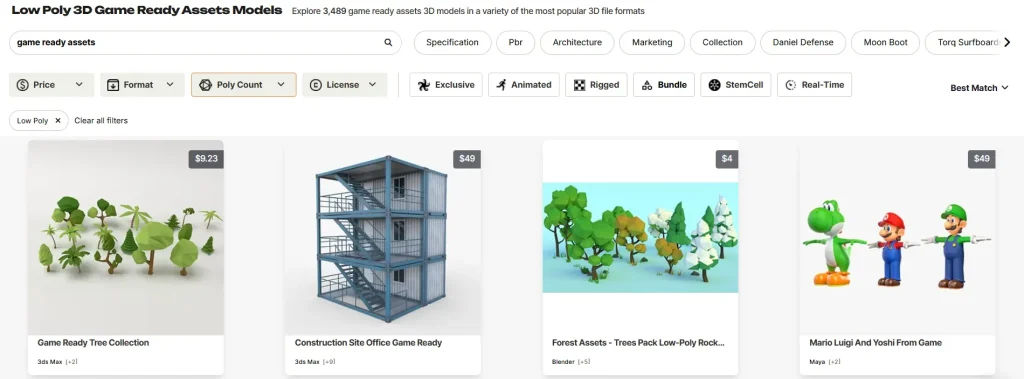
Source: turbosquid.com
Action step: Focus on developing 5-10 premium assets with comprehensive documentation and tutorials.
22. Subscription communities
Subscription communities generate recurring passive income by providing exclusive content, networking, and resources to paying members.
Initial investment: $500-3,000
- Community platform: $50-300/month
- Initial content creation: $300-1,500
Time to first dollar: 30-90 days
Most subscription communities begin generating revenue immediately through founding member programs.
Monthly income potential: $1,000-$20,000+
- Small communities (50-200 members): $1,000-4,000/month
- Medium communities (200-500 members): $4,000-10,000/month
- Large communities (500+ members): $10,000-20,000+/month
| Pros 🚀 | Cons 🧐 |
| Predictable recurring revenue | Requires consistent presence and engagement |
| Community members often create valuable content | Content calendar needed for ongoing value |
| High lifetime value per customer (often 12+ months) | Customer support demands increase with size |
| Lower churn than individual digital products | Harder to fully automate than other passive streams |
✅ Reality check: Launched in early 2024, The Flow Trip is a media brand and a subscription community that offers a bimonthly magazine and a free multi-day newsletter.
Within its first year, it racked up 13,000 paid subscribers, each paying between $72 and $108 perennial. The Flow Trip’s founder, Adam Neumann, aims to reach 20,000 paid subscribers by the end of 2025.
Action Step: Begin with a focused “founding member” launch of 30-50 people at a reduced rate, co-creating the community experience with these early adopters. You can increase urgency and conversion rates on limited-time offers, such as sales, course discounts, or exclusive memberships with an email countdown timer.
23. Investing in creator royalties
Creator royalty investing involves purchasing fractional ownership of music, video content, or other creative works, earning passive income from ongoing royalty streams.
Platforms like Royalty Exchange facilitate such investments by allowing users to purchase rights to music royalties, offering a marketplace for both mainstream and niche music assets.
Initial investment: $1,000-50,000+
- Small royalty shares: $1,000-5,000
- Medium royalty portfolios: $5,000-25,000
Time to first dollar: 30-90 days
Most royalty platforms distribute payments quarterly.
Monthly income potential: $8-$833+ per $10,000 invested
- Emerging creators: 3-6% annual yield
- Established creators: 6-9% annual yield
- Premium catalogs: 8-12% annual yield
| Pros 🚀 | Cons 🧐 |
| Truly passive with zero management | Limited liquidity in secondary markets |
| Uncorrelated with stock market performance | Performance dependent on creator’s ongoing popularity |
| Potential for both income and appreciation | Catalog valuation complexity |
| Access to previously unavailable asset class | Potential regulatory changes in emerging market |
✅ Reality check: For example, 1% ownership in rapper Lil Dicky’s music catalog purchased for $85,000 generates approximately $950 monthly (13.4% annual yield). But a $21,000 investment in sound effects yields just $110 monthly (6.3% return) with declining performance. Mainstream music consistently outperforms niche content despite higher acquisition costs.
Action step: Start with smaller investments ($1,000-5,000) across 3-5 different creators rather than concentrating on a single artist, focusing on established works with 3-5 years of performance history.
24. Car rental platforms (Turo)
Car rental platforms enable vehicle owners to rent their cars to travelers, generating income from an asset that typically depreciates without producing revenue.
Initial investment: $5,000-50,000+
- Vehicle acquisition: $5,000-30,000
- Insurance and platform fees: $500-1,500 annually
Time to first dollar: 7-30 days
Well-positioned vehicles typically receive their first bookings within 1-4 weeks of listing.
Monthly income potential: $200-$2,500+ per vehicle
- Economy vehicles: $200-600/month net profit
- Mid-range vehicles: $600-1,200/month net profit
- Luxury vehicles: $1,200-2,500+/month net profit
| Pros 🚀 | Cons 🧐 |
| Leverage existing assets | Vehicle wear and depreciation |
| Higher returns than traditional investments | Cleaning and maintenance requirements |
| The platform handles booking, payments, and insurance | Potential for difficult guests or damages |
| Scalable by adding multiple vehicles | Seasonal fluctuations in demand |
✅ Reality check: William Huffhine transformed this side hustle into a full-time endeavor, earning over $100,000 a year by managing a fleet of vehicles through Turo.
But it is important to recognize that while car-sharing can generate income, it’s not completely passive. Hosts need to invest time in vehicle maintenance, customer communication, and providing a positive rental experience.
Action step: Start by listing a vehicle you already own before purchasing specifically for rental platforms, focusing on vehicles with strong local demand and low depreciation rates.
25. Domain flipping
Domain flipping involves purchasing undervalued domain names and reselling them at higher prices to businesses or end users who need specific web addresses.
Initial investment: $500-5,000
- Domain purchases: $300-3,000 (10-100 domains)
- Domain marketplace fees: $100-500
Time to first dollar: 30-120 days
Domain portfolios typically begin generating sales within 1-4 months.
Monthly income potential: $300-$5,000+
- Beginning investors (20-50 domains): $300-1,000/month
- Experienced investors (50-200 domains): $1,000-3,000/month
- Professional investors (200+ domains): $3,000-5,000+/month
| Pros 🚀 | Cons 🧐 |
| Low ongoing maintenance requirements | Unpredictable sales timing and volume |
| Potential for significant ROI on individual domains | Annual renewal fees for unsold domains |
| Can be managed in just 1-2 hours weekly | Research-intensive for profitable acquisitions |
| No customer service or product delivery involved | Market knowledge crucial for success |
✅ Reality check: Jeremy Green Eche, a trademark attorney from Brooklyn, New York, purchased the domain name HarrisWalz.com in 2020 for approximately $9, anticipating that Kamala Harris might select Minnesota Governor Tim Walz as her running mate.
When Harris announced Walz as her VP pick in 2024, Eche sold the domain for $15,000, demonstrating the potential profitability of strategic domain investments.
Action step: Develop a specific investment thesis focusing on emerging industries, trending business models, or specific domain patterns. Avoid randomly purchasing domains that “sound good.”

Source: reddit.com/r/Domains
26. Vending machines
Vending machines generate passive income by selling products automatically without staff, providing 24/7 revenue from strategic locations.
Initial investment: $2,000-10,000+
- Machine purchase: $1,500-8,000 per machine
- Initial inventory: $300-1,000
Time to first dollar: 7-30 days
Well-placed machines begin generating revenue immediately after installation.
Monthly income potential: $100-$500+ per machine
- Low-traffic locations: $100-200/month per machine
- Medium-traffic locations: $200-350/month per machine
- Premium locations: $350-500+/month per machine
Pros 🚀:
- Fully automated sales process
- Cash flow begins immediately
- Straightforward business model with predictable margins
- Scalable by adding machines
Cons 🧐:
- Regular restocking and maintenance required
- Location dependency for profitability
- Significant upfront capital per income unit
- Potential for vandalism or theft
✅ Reality check: Megan Healey, a 26-year-old entrepreneur from Manchester, UK, transitioned from a finance career to launch Vault Vending. Starting with a $1,400 investment in her first machine, which initially generated modest returns, Healey expanded to 27 machines across 18 locations over three years.
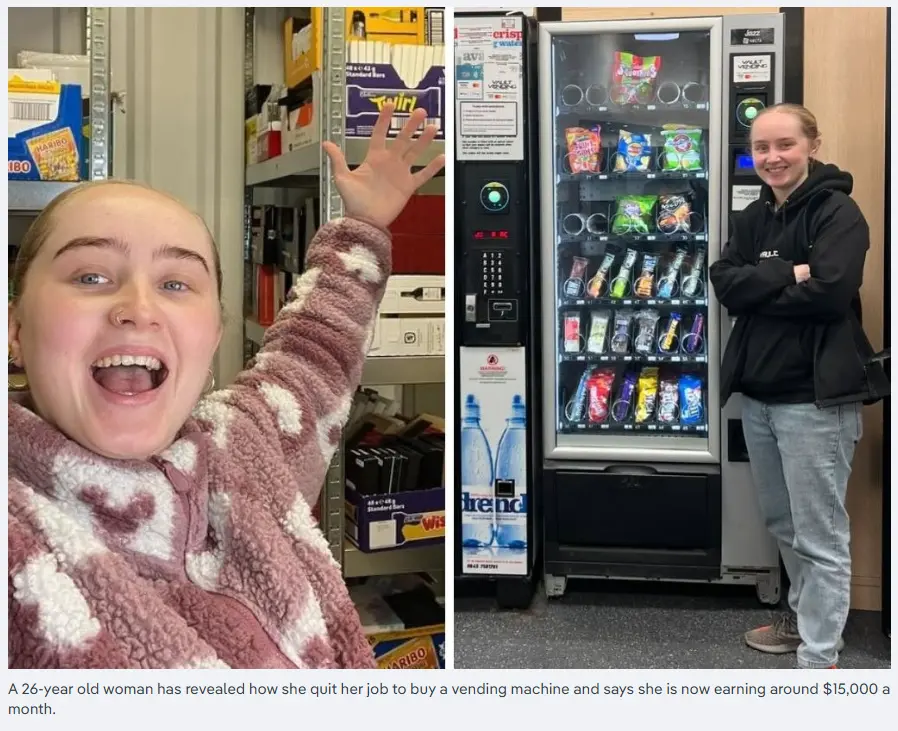
Source: realcommercial.com.au
Her business now generates approximately $180,000 annually, with her most profitable machine located in an aged care home, offering products like Coca-Cola with up to 150% profit margins.
Action step: Secure 2-3 quality locations through formal agreements before purchasing machines, focusing on locations with captive audiences (workforce of 30+ people with limited nearby food options).
27. ATM ownership
ATM (Automated Teller Machines) ownership generates passive income through transaction fees each time someone withdraws cash.
Initial investment: $2,500-25,000+
- ATM purchase: $2,000-8,000 per machine
- Cash inventory: $500-20,000 per machine
Time to first dollar: 7-30 days
Properly placed ATMs begin generating transaction fees immediately after installation.
Monthly income potential: $300-$2,000+ per machine
- Low-traffic locations: $300-600/month per machine
- Medium-traffic locations: $600-1,200/month per machine
- High-traffic locations: $1,200-2,000+/month per machine
| Pros 🚀 | Cons 🧐 |
| Predictable transaction fee income | Significant cash float required |
| Minimal product inventory (cash only) | Regular servicing and cash replenishment |
| Relatively low competition in many areas | Location contracts and relationships crucial |
| Long equipment lifespan (7-10+ years) | Security concerns with cash handling |
✅ Reality check: Paul Alex, a former police officer in San Francisco, began investing in ATMs in 2018 with an initial purchase of six machines, each costing approximately $2,100. He strategically placed them in high-traffic areas and achieved a net profit of about $3,000 monthly.
Expanding his portfolio to 30 ATMs by 2021, Alex generated up to $1,500 monthly per machine. This enabled him to transition from law enforcement to full-time ATM operations, with his company, ATMTogether, reaching $12 million in sales and $3.5 million in net profit by April 2023.
Action step: Analyze foot traffic patterns and focus on venues where cash is frequently needed but not readily available (festivals, cash-only businesses, and entertainment districts).
28. Renting storage space
Renting storage space transforms unused areas in your property into passive income through monthly rental fees.
Initial investment: $500-3,000
- Space preparation and security: $300-1,500
- Insurance coverage: $200-500 annually
Time to first dollar: 7-30 days . Clean, secure storage spaces typically rent within 1-4 weeks of listing.
Monthly income potential: $100-$1,000+ per space
- Small spaces (closets, partial garages): $100-300/month
- Medium spaces (full garages, basements): $300-600/month
- Large spaces (outbuildings, warehouses): $600-1,000+/month
| Pros 🚀 | Cons 🧐 |
| Uses otherwise unproductive space | Security and liability considerations |
| Minimal ongoing maintenance requirements | Zoning and HOA restrictions in some areas |
| Higher returns than traditional rentals per square foot | Limited scaling unless you own multiple properties |
| Lower tenant interaction than residential rentals | Potential for abandoned items and disputes |
✅ Reality check: Marcus B., a property owner in California, began renting out a portion of his unused garage space. Starting with a small 200-square-foot area, he earned approximately $200 per month by renting to individuals needing temporary storage for furniture.
Seeing the demand, he expanded by converting an unused shed into a larger storage space and rented it for $500/month. With just minimal management, Marcus now earns over $2,500 per month from renting out multiple spaces across his property.
Action step: Research local market rates for commercial storage and price your offering 15-20% below commercial rates while highlighting benefits like better security or 24/7 access.
29. Licensing IP
Licensing IP (intellectual property) involves granting others the right to use your creative work (music, design, software, inventions) in exchange for royalty payments.
Initial investment: $500-5,000+
- Creation costs: Variable based on medium
- Copyright/patent registration: $50-5,000+ depending on protection type
- Legal consultation: $300-1,000+
- Portfolio website: $100-500
Time to first dollar: 90-365 days
Licensing deals typically take 3-12 months to negotiate and finalize, with the first royalty payments arriving 30-90 days after the initial commercial use.
Monthly income potential: $200-$50,000+
- Music licensing: $200–$20,000+/month
- Art licensing: $100–$5,000+/month
- Patent royalties: $500–$10,000+/month
- Trademark licensing: $1,000–$50,000+/month
| Pros 🚀 | Cons 🧐 |
| Truly passive once deals are finalized | Significant upfront creation time |
| No fulfillment or customer service required | Hard to break into without an established reputation |
| The same creation can be licensed in multiple ways | Legal complexity in negotiations and contracts |
| Can generate income for decades (life of copyright or patent) | Unpredictable income fluctuations |
✅ Reality check: Tony Anderson is a composer specializing in ambient and neoclassical music who has achieved significant success through licensing his compositions for film and TV. After steadily building a portfolio of over 40 tracks over five years, Anderson’s music now generates over $20,000 per month through placements in commercials, films, and YouTube videos.
Action step: Instead of creating random work hoping for licensing opportunities, research the most commercial applications in your field (corporate videos, podcast intros, app soundtracks), then create a small collection (5-10 pieces) specifically designed for those high-demand categories.
30. E-books
E-books transform your knowledge or creative writing into digital products that generate ongoing passive income through platforms like Amazon KDP or your own website.
Initial investment: $100–$1,000
- Writing tools: Free tools like Google Docs or paid tools like Scrivener ($40) or Grammarly ($12/month) to assist in writing and editing.
- Formatting software: $0–$50 (e.g., Calibre, Adobe InDesign)
- Cover design: $50–$300 (DIY or hire a designer)
- Publishing platform fees: Most platforms take a percentage of sales (e.g., Amazon KDP takes 30-70%).
Time to first dollar: 7-30 days
E-books typically begin selling within 1-4 weeks of publication.
Monthly income potential: $100-$5,000+
- New authors (1-3 books): $100-500/month
- Established authors (3-10 books): $500-2,000/month
- Authority authors (10+ books or bestsellers): $2,000-5,000+/month
| Pros 🚀 | Cons 🧐 |
| Zero reproduction or inventory costs | Significant time investment for quality creation |
| Automated delivery and payment | Growing competition in popular categories |
| Long-term sales potential (5+ years) | Marketing required for visibility |
| Multiple platform distribution possibilities | Platform dependency risks |
✅ Reality check: Mark Manson, author of “The Subtle Art of Not Giving a F*ck,” initially self-published his e-book in 2016. Despite modest earnings early on, the book gained traction through word of mouth and his dedicated blog audience.
It eventually became a New York Times bestseller. By licensing the book to a major publisher and continuing to use his growing platform, Manson’s e-book became a massive success, earning millions in royalties.
Action step: Create an automated tripwire funnel that first offers a low-cost product and automatically upsells a more expensive product, boosting your sales on autopilot.
Principles for making passive income successful
After analyzing different ways to make passive income in hundreds of passive income case studies, several core principles emerge that separate sustainable success from short-term experiments.
1. The 80/20 rule of passive income
The most successful passive income earners focus intensely on optimizing their most profitable assets, not constantly creating new ones. Typically, 20% of your passive income sources will generate 80% of your revenue.
👉To do: Identify your highest-performing assets and double down by creating “content clusters” around them rather than pursuing entirely new topics or products.
2. The two-year mindset
Nearly every successful passive income case study shows minimal returns during the first 6-12 months, followed by exponential growth in years 2-3. Most people quit during the “plateau of disappointment” that typically occurs 4-8 months into any new passive income venture.
👉To do: Before starting any passive income stream, commit to a minimum two-year timeline without expecting significant results in the first year.
3. Systems over goals
Goals focus on outcomes (earning $5,000/month), while systems focus on processes (publishing weekly content consistently). The most sustainable passive income streams emerge from consistent systems, not overly ambitious targets.
👉To do: Design a weekly schedule with 3-5 non-negotiable actions that build your passive income streams, focusing on consistency instead of immediate results.
4. Stacking multiple streams
The average millionaire has seven income streams, with most successful passive income earners maintaining 3-5 complementary streams. They are not focusing on a single source.
👉To do: Once you’ve established one passive income stream generating at least $500 monthly, begin developing a second stream that uses the same skills or audience but with a different business model.
5. Audience before monetization
Building a loyal audience creates multiple monetization opportunities. Successful creators typically focus on audience building for 6-12 months before optimizing monetization.
👉To do: Set audience growth targets before revenue targets and measure engagement metrics to ensure quality over quantity. Create a pre-launch campaign that builds anticipation and automatically sends your audience updates, keeping them informed and ready for your product release.
The term “passive income” often creates unrealistic expectations of money appearing while you sleep with no effort. It sure is more nuanced: passive income requires significant upfront investment (either time, money, or both) and it’s followed by ongoing management and optimization.
The most successful passive income earners view their streams as businesses that require periodic attention. Completely hands-off sources of revenue are extremely rare. Successful passive income earners typically spend 5-10 hours weekly maintaining and optimizing their passive income streams, focusing on high-leverage activities.
For most people, the path to significant passive income ($5,000+ monthly) takes 2-3 years of consistent effort. But once established, these income sources provide flexibility, security, and opportunities that traditional employment just cannot match.
The question isn’t whether passive income requires work. It definitely does. The question is whether you’d prefer to:
- Work intensely for 1-2 years building assets that generate income for decades, or
- Work every month for decades with income that stops the moment you stop working
💡 Are you ready to turn time-limited offers into long-term income?Use Deadline Funnel to automate urgency, increase conversions, and build passive income funnels that scale even while you sleep.


